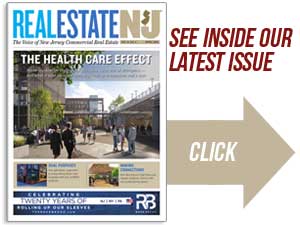By Michael G. McGuinness
 People often spend considerable time coming up with a new name to call attention to something, especially if it has undergone a positive change. That makes sense in the world of marketing or to denote ownership. Our own state went through a host of name changes over the centuries, including Lenapehoking, Lorraine, New Sweden, New Netherland and, ultimately, New Jersey. Another example is how public officials and economic development advocates are working on a name for the next generation of New Jersey’s incentive programs — Grow NJ, Forward NJ, Grow Forward. How about “Grow Up NJ,” as in learning how to be more disciplined and live within our means?
People often spend considerable time coming up with a new name to call attention to something, especially if it has undergone a positive change. That makes sense in the world of marketing or to denote ownership. Our own state went through a host of name changes over the centuries, including Lenapehoking, Lorraine, New Sweden, New Netherland and, ultimately, New Jersey. Another example is how public officials and economic development advocates are working on a name for the next generation of New Jersey’s incentive programs — Grow NJ, Forward NJ, Grow Forward. How about “Grow Up NJ,” as in learning how to be more disciplined and live within our means?
Those of us who are parents and business executives do it all the time. Setting and adhering to a budget is integral to success and sanity. It requires constant monitoring to ensure the funds are there to maintain the organization, and the ability to readily shift course when circumstances warrant. People charged with these responsibilities must recognize their limitations, understand their audience and balance meeting today’s demands with investing in the future.
Investing in (financing) the future is a topic that Bruce Katz and Jeremy Nowak laid out well in their book “The New Localism.” As they state, “Economic competitiveness and social cohesion require intentional investments in innovation, infrastructure and inclusion.” Included here are the ideas and scientific research to foster next-generation technologies; robust transportation, water, energy and communication systems to better align with today’s economy and lifestyles; and quality education, more effective schools, skills training and affordable housing. I would argue that Gov. Murphy’s vision for New Jersey as a state of innovation nicely captures the element of inclusion in its goals.
However, our state still needs to meet today’s demands: retaining and growing jobs; remaining relevant to attract emerging industry sectors; and, perhaps most importantly, making New Jersey sufficiently affordable for the workforce. Incentives can be powerful tools for reaching some of these goals, but the old programs must be revamped to align with today’s needs and diminished resources so that they are sustainable and meaningful. We cannot be shortsighted, as these investments take time to mature and bear fruit. Hopefully over time, the state may be able to rely less on incentives, but that won’t be possible until the total costs of operating local, regional and state government entities are dramatically lowered through private-sector type efficiencies, which may be much more effective in delivering services.
It was recently announced that the Hudson Rail Tunnel Project (Gateway) cost has been reduced by $1.4 billion. What took so long? Think of the myriad cost savings that could be replicated across New Jersey if every taxing jurisdiction and government entity scrutinized the cost effectiveness of their delivery of services. Many would become extinct overnight.
For this reason, NAIOP strongly supports a legislative package, stemming from Senate President Steve Sweeney’s 2018 Path to Progress report, which would help New Jersey grow beyond its crushing financial challenges. These are courageous initiatives whose time has come. Included are proposals to: change the Public Employees’ Retirement System and the Teachers’ Pension and Annuity Fund; reform the delivery of state employee health benefits; require consolidation plans for school districts within a county; establish a pilot program in the Department of Education for the organization of county administrative school districts; require municipalities, counties, school districts and local authorities to regularly meet to discuss shared service agreements; establish a County and Municipal Study Commission; permit additional county tax assessment systems and revise how assessments are determined across the state; require counties to appoint shared services coordinators; establish an Office of Local Government Efficiency within the Department of Community Affairs; and require the Edward J. Bloustein School of Planning and Public Policy at Rutgers University to undertake a study to determine efficiency and scaling in delivery of local government services.
Another timely example of a public policy proposal in need of a reality check is the proposed New Jersey Draft 2019 Energy Master Plan (EMP), for which comments are due to the state Board of Public Utilities by Sept. 16. As currently drafted, it is far too overreaching and aspirational to be viewed seriously. Furthermore, it borders on being irrational and irresponsible, given our current level of technology, limited resources and the anticipated costs of implementation. The EMP’s call for the full conversion to clean energy by 2050 comes with an estimated price tag of $115 billion, not counting the billions it would cost to retrofit existing commercial and residential buildings, and the higher costs to ratepayers resulting from the elimination of natural gas as an energy source.
The EMP also fails to address the reliability and resilience of the grid and power supply, which are critical. There is no analysis on how to maintain reliability in a system that seeks to be 100 percent clean energy with near total reliance on distributed energy resources, such as rooftop solar photovoltaic units, wind generating units, battery storage and combined heat and power units. Distributive generation, or micro-grids, are key to enhancing resilience to massive disruptions such as Superstorm Sandy. If we delete natural gas from the equation, how would the system be backed up, given that battery storage technology has not yet sufficiently advanced? At a minimum, the EMP should include an economic impact analysis by a credible third party, especially since energy costs affect the state’s competitiveness and are a key factor in business location and profitability.
As Stephen Covey put it, we need to continuously “sharpen the saw” and improve our game to remain relevant and competitive. Now is a time for bold ideas and a course change, or New Jersey’s parochialism and love of home rule may be our death knell. It is time to regionalize our efforts and scale up investments in critical infrastructure, ideas and people. Again, I’d like to borrow from Bruce Katz and Jeremy Nowak’s “New Localism:” “The right investments in terms of scale, quality and public value require civic and public decision makers with a long-term view of growth and the ability to negotiate complex transactions.” How many of our hundreds of governmental jurisdictions have the bandwidth to meet that challenge?
Michael McGuinness is CEO of NAIOP New Jersey and has led the commercial real estate development association since 1997. NAIOP represents developers, owners, asset managers and investors of commercial, industrial and mixed-use properties, with 830 members in New Jersey and over 19,000 members throughout North America.









